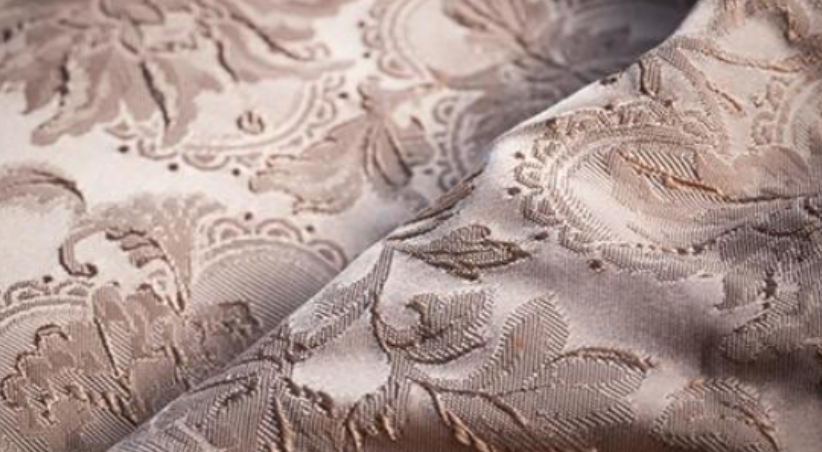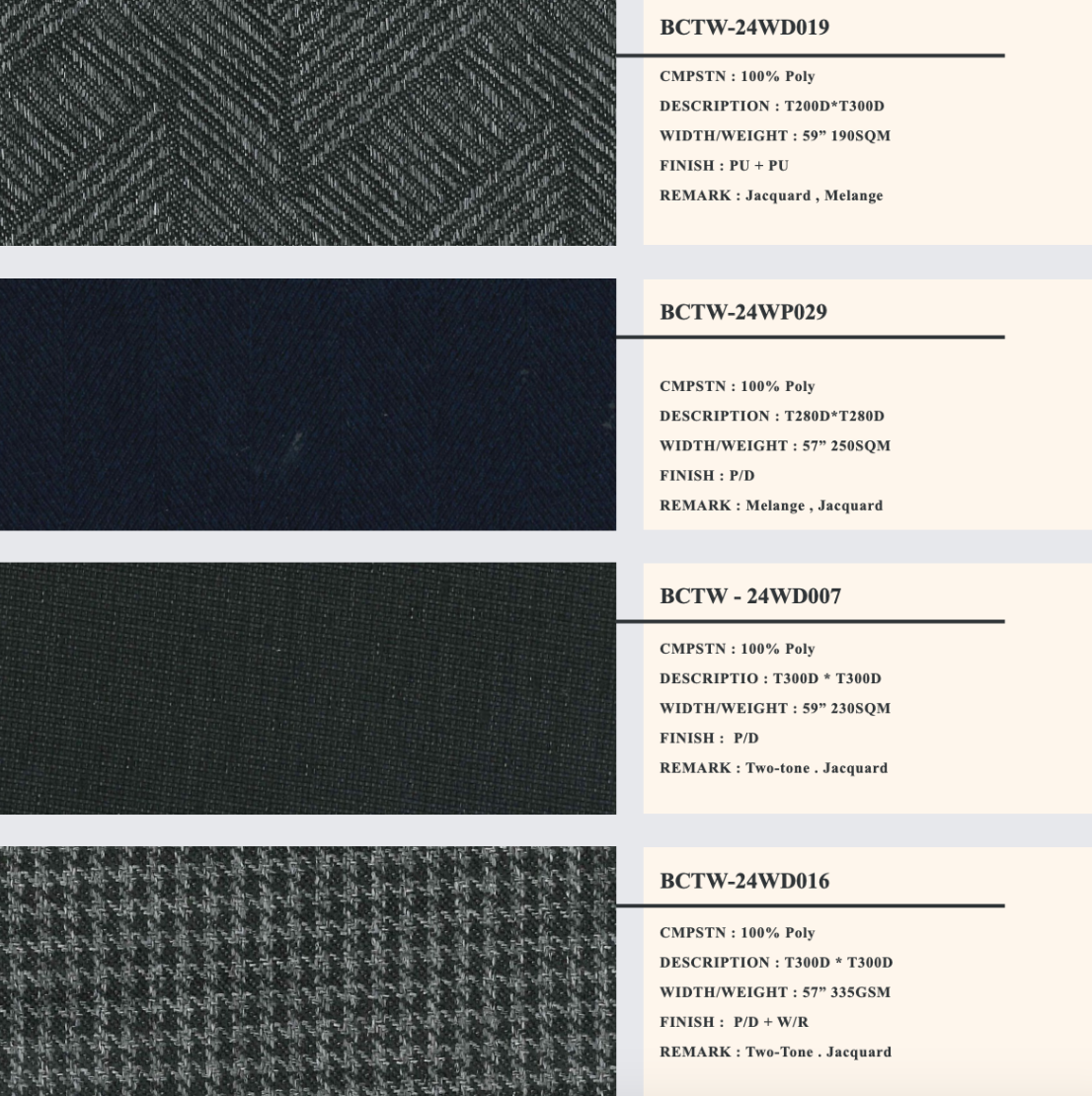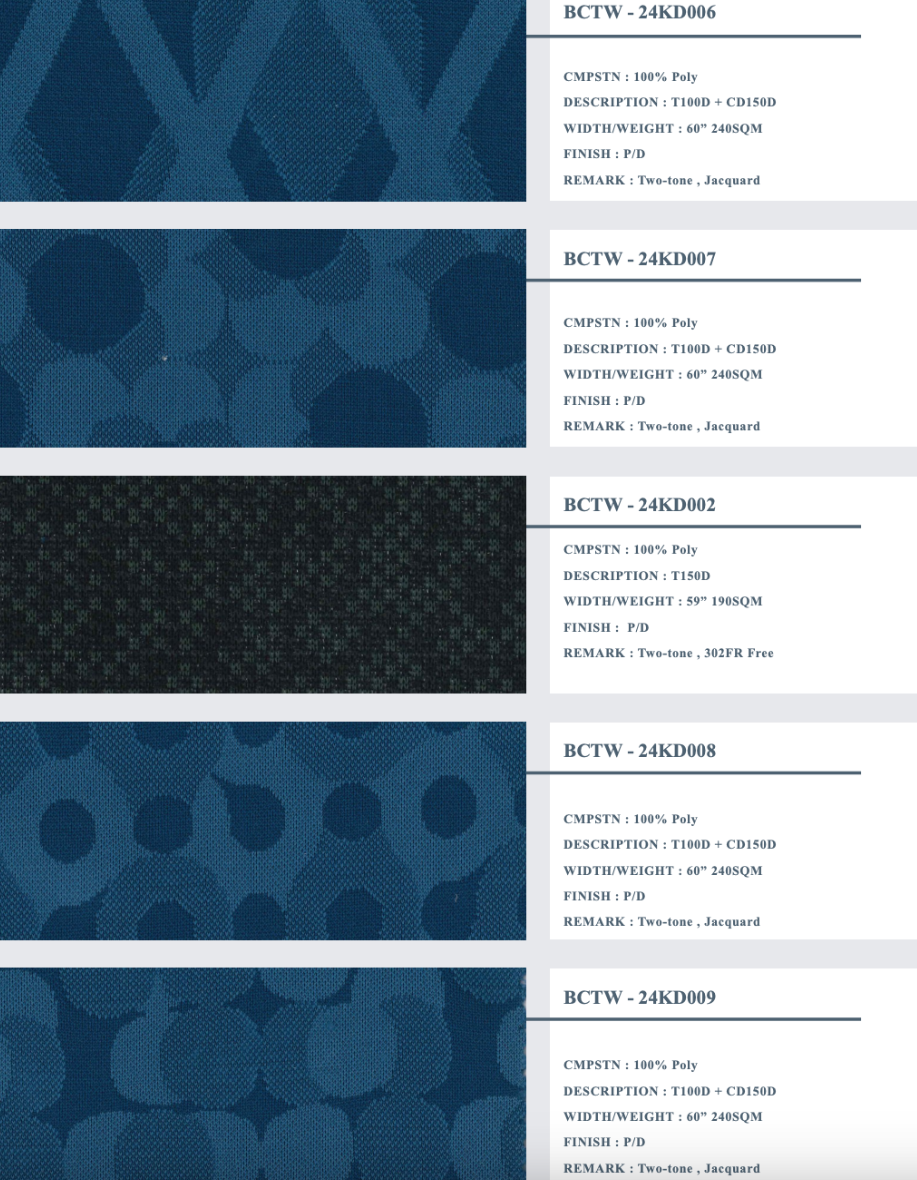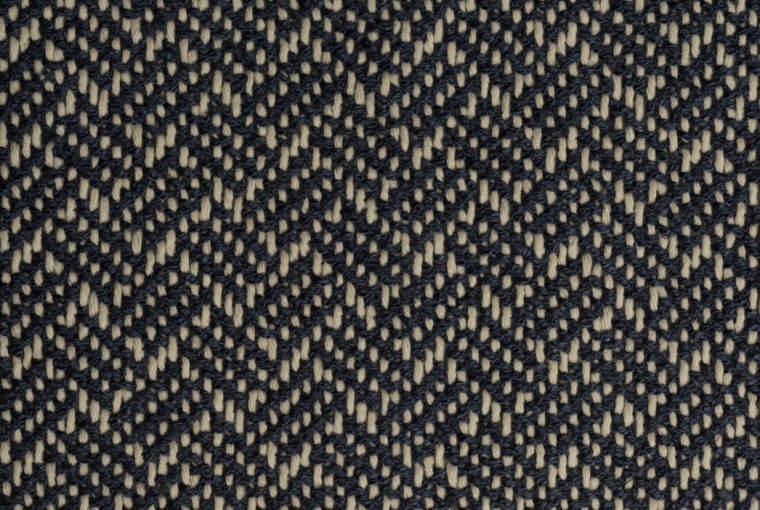More Details
Jacquard fabric is a timeless masterpiece in the textile world, celebrated for its luxurious feel, intricate patterns, and versatility. Whether you’re designing elegant fashion pieces or sophisticated home décor, Jacquard fabric stands out as a choice that combines beauty and durability. In this guide, we’ll explore everything you need to know about Jacquard fabric—from its fascinating history and creation process to its many types and uses. Let’s dive in!
Read more: A Complete Guide to Dobby Fabric: Types, Uses, Characteristics
What is Jacquard Fabric?
Jacquard fabric is a premium textile known for its intricately woven patterns that you can see and feel. Unlike printed fabrics, where designs are applied on top of the material, Jacquard patterns are woven directly into the fabric using advanced looms. But what is a pattern woven into a fabric called? It’s referred to as a Jacquard pattern, a design created through a meticulous weaving process. The term “Jacquard” is derived from the Jacquard loom, invented by Joseph Marie Jacquard in 1801. This innovative machine revolutionized the weaving industry by allowing the creation of complex patterns with unparalleled precision.
Fun fact: Did you know that Jacquard-like fabrics have been around since ancient China’s Shang Dynasty (1600 BCE–1046 BCE)? The art of weaving intricate patterns has been cherished for centuries, making Jacquard fabric a true testament to craftsmanship.
Define Jacquard
So, what exactly does Jacquard mean? Jacquard refers to a type of fabric featuring complex patterns woven directly into the material, rather than printed or embroidered. The Jacquard weaving process allows looms to precisely control each warp thread, making it possible to create detailed and sophisticated designs.

Jacquard Pattern: Art in Every Thread
A Jacquard pattern is created by weaving threads into intricate designs, from floral motifs to geometric shapes. This technique allows for stunning detail and texture, giving the fabric its signature luxurious feel. Explore some of the Jacquard patterns we offer at Yu-City. Want to learn more? Reach out to us!

What is Jacquard fabric used for?
Jacquard fabric’s versatility makes it ideal for various applications, including:
1. Fashion
Create statement pieces like suits, dresses, and jackets with Jacquard’s luxurious texture.
2. Home Décor
Perfect for curtains, upholstery, and bed linens, adding a touch of elegance to your space.
3. Specialty Applications
Designers often use Jacquard in baby strollers, handbags, and even footwear for a unique and sophisticated look.
How is Jacquard Fabric Made?
Today, jacquard fabrics are made on a large scale using advanced machinery. Their signature raised patterns are created by controlling individual warp threads through punched cards or computerized systems. Thanks to modern technology, jacquard fabrics no longer require tedious handwork or large amounts of labor to produce intricate and stunning designs. Yet, they still maintain their timeless elegance and charm. These fabrics add beauty and artistry to clothing and home décor, making them a favorite choice for enhancing any space.
Skilled textile designers start by converting design patterns into weaving drafts, which outline the color, placement, and details for each part of the design. High-quality yarns, like silk or cotton, are carefully chosen, dyed, and pre-treated to ensure consistent color before they are woven. The jacquard loom, powered by digital programming, brings these patterns to life. Instructions guide the loom’s hooks, shuttles, and other mechanisms to weave the threads together and create the desired patterns with precision.
After weaving, the fabric is finished and processed to ensure it feels smooth and soft to the touch. Following a strict quality check, the jacquard fabric is ready to be transformed into stunning designs or practical applications.
Step-by-Step Guide
Step 1: Design Creation
The first step in making Jacquard fabric involves designing the intricate pattern. Designers use specialized software or manually create the designs that will be woven into the fabric. The complexity of Jacquard patterns requires precise planning to ensure every thread aligns correctly to form the desired motifs.
Step 2: Thread Selection
Different types of yarns are chosen depending on the intended use and look of the fabric. Common materials include:
- Cotton: Lightweight and breathable, perfect for casual wear or home décor.
- Silk: Adds a luxurious shine, often used for formal clothing and upholstery.
- Polyester: Offers durability and wrinkle resistance, ideal for functional purposes like strollers or upholstery.
- Blends: Combining fibers like cotton and polyester creates versatile fabrics with combined benefits.
Step 3: Weaving
The Jacquard loom, an advanced weaving machine, interlaces threads to form the intricate patterns. Each thread is controlled individually, allowing for complex designs to be woven directly into the fabric. Unlike printed or embroidered patterns, Jacquard designs are part of the fabric’s structure, ensuring durability and texture.
Step 4: Finishing
After weaving, the fabric undergoes finishing processes to enhance its appearance and usability. This may include:
- Dyeing: To add vibrant colors or subtle tones.
- Softening: Ensures the fabric feels comfortable to the touch.
- Durability Treatments: Provides resistance to wear and tear, especially for upholstery or outdoor use.
Types of Jacquard Fabric
Jacquard fabric comes in many varieties, and you’ve likely encountered some of them in everyday life, like brocade or damask. These fabrics can also be classified based on the materials they’re made from. Understanding their unique characteristics can help you choose the right type of jacquard fabric for your needs.
1. Brocade
Brocade has its roots in ancient China, where it was originally made on the draw loom, a precursor to the jacquard loom. Known for its intricate and elegant patterns—such as dragons, phoenixes, and delicate floral designs—it was traditionally worn by nobility. Today, brocade is created on modern jacquard looms, offering an even broader range of patterns and materials.
2. Brocatelle
Similar to brocade, brocatelle has a more pronounced raised effect and defined texture. It is woven using various types of yarns and often incorporates different colors and metallic threads to enhance the patterns.
3. Damask
Damask is known for its intricate woven patterns, and its name originates from the city of Damascus, a significant hub along the Silk Road famous for silk production and trade. It features reversible designs and is woven on jacquard looms to create detailed, contrasting patterns.
4. Matelassé
Derived from the French word meaning "padded," matelassé fabric is made using a jacquard loom or quilting machine, resulting in a raised and textured surface. Typically made from cotton or a cotton blend, this fabric is admired for its thick, luxurious appearance and unique texture, with identical patterns on both sides. It’s ideal for creating bedding, coverlets, and pillowcases.
5. Tapestry
Tapestry is usually produced on a loom using hand weaving techniques to create intricate and detailed designs. This process involves skillfully manipulating the weft threads to weave elaborate patterns onto the warp. Due to its refined nature, tapestries are often hung and displayed, depicting historical events, mythical scenes, religious stories, and more.
6. Jacquard Knits
Jacquard knits are knitted fabrics created using jacquard knitting techniques. Unlike traditional single-yarn knitting, jacquard knits use multiple yarns of different colors or textures. With various stitch patterns and techniques, these fabrics offer a wide range of color combinations and visual effects.
7. Silk Jacquard
Silk jacquard has been a beloved material since ancient times. Its smooth, glossy surface, combined with intricate jacquard patterns, gives it a luxurious and sophisticated appearance. Silk’s excellent dye absorption results in vibrant colors, while the lightweight and breathable nature of silk jacquard ensures a comfortable experience.
8. Cotton Jacquard Fabric
Cotton jacquard is a gentle fabric that provides a pleasant feel against the skin. Its excellent moisture absorption and breathability keep your body dry and comfortable. Additionally, it is an eco-friendly choice, as natural fibers are biodegradable.
9. Wool Jacquard
Known for its superior insulation, wool jacquard combines warmth with softness, delivering a luxurious feel. Wool fibers naturally have a protective layer, making wool jacquard somewhat water-resistant and stain-resistant.
10. Synthetic Jacquard
Synthetic fibers are known for their durability and wear resistance. Compared to natural fibers, they are less prone to wrinkling. Common synthetic jacquard fabrics, such as polyester and viscose, offer silk-like qualities. Synthetic jacquard is easy to care for, dries quickly, and is convenient to carry, even when traveling.
11. Black Jacquard Fabric
Provides a bold, sophisticated look. Perfect for formal wear like tuxedos or evening dresses.
12. White Jacquard Fabric
Represents purity and elegance. Frequently used in wedding attire and upscale table settings.
13. Floral Jacquard Fabric
Floral Jacquard fabric is a beautiful choice for adding intricate and elegant floral motifs to your designs. Whether for fashion or home décor, it effortlessly brings a sense of charm and personality to any piece. Here are some of the patterns we have in 2024:

At Yu-City, we’ve carefully crafted a diverse range of fabric textures, each offering its own distinct qualities to match your design vision. Our specially introduced floral designs are perfect for adding that extra touch of elegance, creating something truly unique. With boutique-like production processes and a commitment to high-quality textures, your creations will stand out. Whether you’re drawn to the cotton-like feel or the cool, smooth touch, Yu-City can meet your needs. Let’s explore the variety of fabrics together and craft a fashion style that’s entirely yours.
Brocade vs. Jacquard Fabric
While both are woven on a Jacquard loom, there are notable differences:| Feature | Jacquard | Brocade |
|---|---|---|
| Material | Cotton, silk, polyester | Silk, metallic threads |
| Pattern | Woven into fabric | Raised, intricate designs |
| Texture | Can be flat or textured | Highly textured |
| Use | Fashion, casual, home décor | Formal and luxury settings |
| Cost | Varies by material | Generally more expensive |
Price Range of Jacquard Fabric
The price of Jacquard fabric can vary quite a bit, depending on a few factors. First, the material makes a big difference – silk Jacquard tends to be more expensive than cotton or polyester options. The complexity of the design is another important factor; intricate patterns with more threads take more time to produce and, as a result, cost more. The region where the fabric is made also plays a role. For instance, Jacquard from Italy or India is typically more expensive because of the high-quality craftsmanship these regions are known for. Italy is especially renowned for its luxurious, high-end fabrics, while India offers vibrant, detailed patterns created by skilled artisans. On the other hand, China produces a more affordable range of Jacquard fabrics, known for their versatility and accessibility.
Caring for Jacquard Fabric
When it comes to caring for Jacquard fabric, it’s best to keep things gentle. Hand washing or using the delicate cycle on your machine will help protect the intricate patterns and prevent any damage. Always opt for a mild detergent, as harsh chemicals can weaken the fibers or cause the colors to fade. For drying, air-dry the fabric by laying it flat or hanging it up, but avoid direct sunlight to keep the colors from fading.
When it’s time to store your Jacquard fabrics, choose a cool, dry place to avoid mold or mildew. If you're hanging garments, use padded hangers to keep their shape and prevent any creases. A breathable fabric bag is ideal for storing pieces to protect them from dust while still allowing airflow.
The Fascinating History of Jacquard Fabric
During the Eastern Han Dynasty (25–220 CE), a type of jacquard loom called the "Hualou" was developed. The "Huaben," a kind of program used to store pattern information, made it possible to create intricate designs. This invention marked a major achievement in ancient Chinese weaving technology. The Hualou loom required two people to operate. One person sat on the three-foot-tall Hualou to manage the warp threads, while the other used foot pedals to control the weft threads. It wasn’t until the 6th or 7th century that this type of jacquard loom, along with cross-stitch embroidery techniques, made its way to Europe, making it possible to produce detailed jacquard fabrics there.
In 1804, Joseph Marie Jacquard patented his version of the jacquard loom. His design, inspired by earlier Chinese looms like the Hualou, was a significant improvement. It could weave patterns 25 times faster than traditional manual looms, making jacquard fabrics widely accessible and popular. Automating the weaving process made it much easier and faster to create intricate patterns, completely transforming how fabrics were made. As technology advanced, the early mechanical looms were replaced with computerized systems, making it possible to produce even more detailed and complex designs. What once was a fabric exclusively for the wealthy has now become a symbol of everyday luxury, all while preserving its artistic and cultural importance.
Why Jacquard Fabric Stands the Test of Time
Jacquard fabric’s unique combination of beauty, durability, and versatility has ensured its enduring popularity. Whether for a striking dress, a timeless home décor piece, or a practical item like a stroller canopy, Jacquard fabric continues to inspire and impress.
At Yu-City, we believe in more than just providing fabrics. We’re here to be a true partner in your creative journey, sharing the latest industry trends, offering expert product marketing, and conducting in-depth business research. With our comprehensive approach, we help you choose the perfect Jacquard fabric and pattern while guiding you in finding the right manufacturer to meet your needs.
FAQs
1. Is Jacquard fabric good?
Yes, Jacquard fabric is highly regarded for its exceptional quality, durability, and aesthetic appeal. The intricate patterns woven into the fabric provide a luxurious and sophisticated look, making it ideal for fashion, upholstery, and home décor. Additionally, its versatility allows it to be made from various materials, such as cotton, silk, and polyester, catering to diverse needs and preferences.
2. Is Jacquard better than cotton?
It depends on the use case:
- Design: Jacquard fabric is more decorative and textured, making it better for formal clothing and home décor. Cotton, being simpler and lighter, is ideal for casual wear and basic textiles.
- Durability: Jacquard, especially made from synthetic blends or silk, tends to be more durable than plain cotton.
- Breathability: Cotton is more breathable and comfortable for hot climates.
Ultimately, Jacquard and cotton serve different purposes, with Jacquard excelling in style and cotton excelling in practicality.
3. Is Jacquard cotton or polyester?
Jacquard fabric can be made from a variety of materials, including:
- Cotton: Lightweight and breathable, suitable for casual wear and summer apparel.
- Polyester: Durable and cost-effective, often used in upholstery and functional applications.
- Silk, Wool, or Blends: Adds luxury and texture, commonly found in high-end fashion or décor.
The material used depends on the intended purpose and desired characteristics.
4. Is Jacquard good for hot weather?
Jacquard can be suitable for hot weather if made from breathable materials like cotton or lightweight silk. Cotton Jacquard, for instance, is airy and comfortable, making it perfect for summer clothing or décor. However, thicker Jacquard fabrics like polyester or brocade may feel heavy and less breathable, making them better suited for cooler climates.
5. What are the advantages of Jacquard?
Jacquard fabric offers several advantages:
- Intricate Patterns: The woven designs add elegance and sophistication.
- Durability: The weaving process ensures the patterns don’t fade or wear off easily.
- Versatility: Available in various materials for different uses, from clothing to upholstery.
- Textural Appeal: Offers a range of textures, from smooth damask to textured brocade.
- Customizable: The patterns can range from simple to highly complex, catering to diverse styles.
6. Is Jacquard waterproof?
Not inherently. However, synthetic Jacquard fabrics like polyester can be made water-resistant through additional treatments. Natural fibers like cotton or silk Jacquard are not waterproof but can be coated with protective finishes to improve water resistance.
7. Does Jacquard wrinkle?
The wrinkle resistance of Jacquard depends on the material:
- Cotton and Silk: These natural fibers are prone to wrinkling.
- Polyester and Blends: These synthetic materials are more resistant to wrinkles, maintaining a neat appearance for longer periods.
Proper care, such as gentle ironing or steaming, can help reduce wrinkles in natural Jacquard fabrics.
8. What fabric is similar to Jacquard?
Fabrics with similar weaving techniques and appearances include:
- Brocade: Features raised, ornate patterns, often considered a type of Jacquard.
- Damask: A reversible fabric with flat, woven patterns, commonly used in home textiles.
- Matelassé: Creates a quilted or padded effect, offering texture and elegance.
- Tapestry: Features elaborate, pictorial designs woven into the fabric, much like Jacquard.
9. Can you wash Jacquard fabric?
Yes, but the washing method depends on the material:
- Hand Wash: Recommended for delicate Jacquard fabrics like silk to prevent damage.
- Machine Wash: Use a gentle cycle for more durable options like polyester or cotton Jacquard.
- Dry Clean: Many Jacquard garments and upholstery require professional cleaning to preserve their intricate designs.
Always check the care label for specific instructions, and avoid harsh detergents or high heat to protect the fabric.
